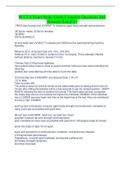STUVIA
Pharm 2 Test 4
Terms in this set (260)
Original
hyperacidity
excessive acid production
hyperacidity left untreated can lead to
acid reflux, ulcer disease, esophageal damage, esophageal cancer
Read More
hydrochloric acid helps with
digestion and serves as a barrier to infection
bicarbonates prevent
hyperacidity
pepsinogen is an enzyme that
digests dietary proteins
intrinsic factors facilitate
gastric absorption of vitamin B12
mucus
%
protects the stomach lining for both hydrochloric acid and digestive enzymes
prostaglandins
variety of anti-inflammatory and protective functions
acid controlling drug classifications
antacids, proton pump inhibitors, H2 receptor antagonists, misc
antacids are a compound used to
neutralize stomach acid
antacid action
neutralize gastric acid, stimulate mucus, bicarbonate, and prostaglandins from cells inside the gastric
glands
antacids do not
prevent overproduction of acid
antacid meds
aluminum hydroxide, magnesium and aluminum hydroxide (maalox, mylanta), calcium carbonate
(tums), magnesium hydroxide (milk of magnesium)
antacid indications
acute relief of symptoms associated with peptic ulcer, gastritis, gastric hyperacidity, heartburn
antacid contraindications
severe renal failure, electrolyte disturbance, GI obstruction
do not give magnesium to
,STUVIA
patients with small bowel obstructions due to laxative effect
magnesium preps can cause
diarrhea
aluminum and calcium preps can cause
constipation
calcium products can cause
constipation, kidney stones, and rebound hyperacidity when discontinued
excessive use of antacids can result in
systemic alkalosis; more common with sodium bicarbonate
hypercalcium
aluminum binds to phosphate and may lead to hypercalcemia
early signs of hypercalcemia
constipation, headache, increased thirst, dry mouth, decreased appetite, irritability, and metallic taste
late signs of hypercalcemia
confusion, drowsiness, increase in blood pressure, irregular heart rate, nausea, vomiting, increased
urination
antacid drug interactions
do not dose any drugs at least 1-2 hours before or after
H2 receptor antagonists
%
reduce but do not completely block acid secretion
H2 receptors are the most
popular drugs for tx of acid related disorders including peptic ulcer disease
H2 receptor antagonists action
completely blocks the H2 receptor of acid producing parietal cells, making the parietal cells less
responsive to histamine and stimulation of gastrin
H2 receptor antagonist meds
cimetidine, ranitidine, famotidine, nizatidine
H2 receptor antagonist indications
Gerd, peptic ulcer disease, erosive esophagitis, adjunct therapy in control of upper GI tract bleeding,
tx of pathologic gastic hypersecretory conditions, zollinger-ellison syndrome, stress ulcer prophylaxis
H2 receptor antagonists contraindications
liver and kidney dysfunctions
H2 receptors antagonists adverse effects
-low incidence
-headache, lethargy, confusion, depression, diarrhea, nausea, cramping
ranitidine danger
potentially causes cancer
proton pump inhibitors (PPIs) action
, STUVIA
directly binds with hydrogen potassium ATPase pump mechanism and irreversibly inhibits the action
of the enzyme, resulting in blocking hydrogen ion secretion from the parietal cells
PPI meds
lansoprazole, omeprazole, rabeprazole, pantoprazole, esomeprazole
PPI indications
first line for erosive esophagitis, GERD poorly responsive to other treatment, short term tx of active
duodenal ulcers and gastric ulcers, zollinger-ellison syndrome, NSAID induced ulcers, stress ulcer
prophylaxis
PPI adverse effects
-well tolerated
-concern when overprescribed
-may predispose pts to GI tract infections
-concern for development of osteoporosis, dementia, and lupus
misc acid controlling drugs
sucralfate, misoprostol, simethicone
sucralfate used for
mucosal protectant in tx of active stress ulcerations and in long term therapy of peptic ulcer disease
sucralfate adverse effects
uncommon but include nausea, constipation, dry mouth
%
take sucralfate ______ before _____ and _____
1 hour before meals, at bedtime
misoprostol has been shown to
reduce incidence of gastric ulcers in patients taking NSAIDS
misoprostol adverse effects
headache, GI distress, vaginal bleeding
simethicone used for
discomforts of gastric or intestinal gas and aid in its release via mouth or rectum
-classified as an anti-flatulent drug
all antacids should be taken
with 8 oz of water to ensure absorption, 2 hours before or after other meds due to altering med
absorption
nursing care for H2 receptor antagonists
assess renal and liver functions, level of consciousness
PPI nursing care
-give on empty stomach 30min-1hour before meals
-assess pts for manifestations of osteoporosis or hx of disorder
contact HCP immediately when taking acid controlling drugs if
severe constipation or diarrhea, increase in abdominal pain, abdominal distention, hematemesis,
black tarry stools, nausea, vomiting





